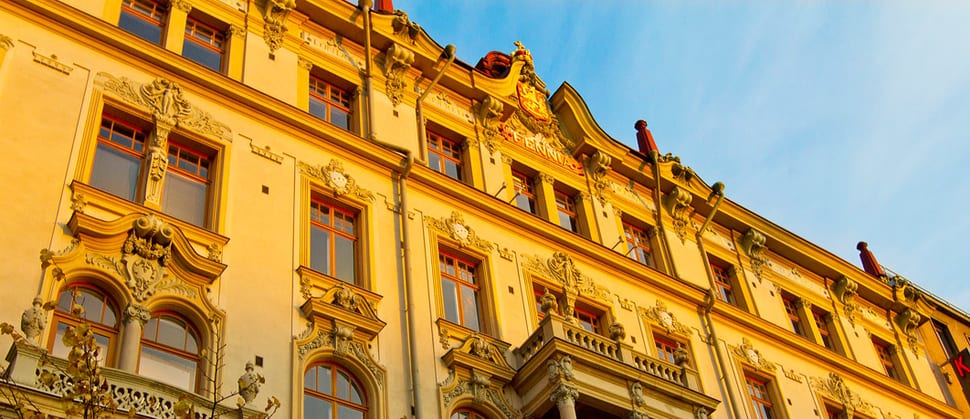
Premium properties tell stories of Finnish history
Sponda owns many buildings of historical significance in Helsinki city centre. During the last hundred years, many properties that initially were private homes have been transformed into retail and office premises. Each one of these buildings that are over 100 years old have their own stories that deserve to be told, especially now that Finland is celebrating its centenary.
Even in the hustle and bustle of the Rautatientori Square, it’s hard to miss the impressive Fennia house. When you squint a little, you can see Finland’s coat of arms in the upper facade and metropolis names written in gold underneath the eaves. The Neo-Baroque building now hosts Grand Casino Helsinki. This is a natural continuum to the property’s history: Fennia has always shown people a good time.
The building was designed by the architect trio Grahn, Hedman and Wasastjernna. You can see their handiwork also only a stone’s throw away in the Aleksi-Hermes building that was completed in 1898 on the corner of Aleksanterinkatu and Keskuskatu and housed both residential and retail spaces. Today, the building is part of Citycenter shopping centre and stands firmly on its roots, offering retail and business premises.

Sponda owns a total of 13 premium properties that are over 100 years old, built between 1870 and 1913. According to Anita Riikonen, Sponda’s Marketing and Brand Manager, each of the buildings has a story to tell also to future generations. Both personal as well as national history has been written inside these walls.
Old buildings stand the test of time and transform with it
Many premium properties in Helsinki city centre have first been residential buildings. Over the decades, needs have changed and, as a result, properties have been renovated into modern retail and office spaces.
“Historical buildings have great potential and their purpose can be developed. Almost all of our premium properties are protected buildings either in their entirety or in part. Because of this, the National Board of Antiquities has participated in the renovations as an expert.”

Riikonen sees that Sponda has a more extensive role than just being the buildings’ owner: As the premium properties are part of the city’s cultural heritage, their owner must also document, file and pass on the buildings’ history to future generations. Maintaining and restoring these premium properties is treasuring cultural heritage at its best.
Sustainable environmental actions
Environmental responsibility is an essential part of sustainable property development. The Kaleva Palace, located at the intersection of Kaivokatu and Mannerheimintie and designed by architect Armas Lindgren, underwent a roofing renovation. The building’s heat insulation was significantly improved during the renovation.
“Realising environmental actions in old premium properties is more challenging than in newly constructed properties. However, energy consumption can be cut also in old protected buildings with the right choices and energy-efficient methods of working.
The distinctive features of the cultural historically significant Kaleva Palace were taken into account in the renovation, as well as technical and structural solutions typical of the era of construction and objectives related to preserving and protecting materials. As a result, this building, which was completed in 1913, now participates in Sponda’s Energy efficiency programme.
Premium properties shine a historical light on businesses
Sponda’s magnificent premium properties are often chosen by businesses that also wish to communicate the company’s brand through distinguished premises. According to Riikonen, the office building, interior design and location have an effect on the images attached to the company. Operating in a premium property instantly connects the brand of the business to part of Finnish history.

“The atmosphere of the building can be sensed already in the staircase. The beautiful staircases and exquisite murals of premium properties are part of constructing the brand of the business.”
This means tenants are very interested in both the history of the building and all related stories.
“We are currently compiling the fascinating stories of our buildings and we will also share them with the Finnish public during the celebratory year. We also want to give chances to take a peek inside the buildings.”
High society parties, weeping divas
In particular the Fennia building, completed in 1898, has a multitude of stories to tell. The opening of Grand Hotel Fennia was celebrated in 1909 where 157 waiters dressed in emerald dress coats took care of the well-being of guests. The hotel was the beating heart of Helsinki’s social life in the 1910s.
Actress Ida Aalberg celebrated her 40 years in the theatre in the hotel, and painter Akseli Gallen-Kallela hosted his 50th birthday there—one of them was moved to tears by the speeches. Only the milieu was enough to bring tears to your eyes, the crown jewel being the winter garden in the courtyard with a dome roof and illuminated eight-metre fountains.

In addition to the Fennia building, there are also tales of other properties, and ghost stories cannot be forgotten, either; for instance at the Seurahuone hotel building on Kaivokatu.
To celebrate Finland’s centenary, Sponda opens more doors to 100 years of history hidden in the premium properties.

Published 14.2.2017
